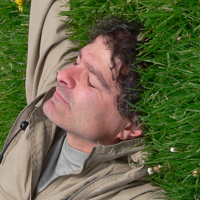 With a background in equilibrium and nonequilibrium statistical mechanics, I’ve worked as a theoretician in the fields of molecular self-assembly, crystal-growth dynamics, protein motors, enzyme inhibitor design, enzyme dynamics, complex systems theory, and ecosystem science and food-web dynamics. But along the way I’ve carried an overarching fascination with metaphor, story, art, and the human necessity of creating meaning. Lately I’ve been thinking deeply (I hope) about what the late physicist David Bohm called the “tacit implicit infrastructure” of science: in other words, the hidden cosmology underlying Science as we practice it today. In addition to my current readings in the philosophy and history of science, my thinking is informed (perhaps oddly, but the resonances throughout are astounding) by Pacific Northwest art and story, poetry, and iconography. And because I believe humans have evolved to, among other things, work with their hands, I’ve studied woodcarving with a talented and generous group of carvers in the San Juan Islands. It’s taken long, but I understand now that making is as potent a form of inquiry as any.
With a background in equilibrium and nonequilibrium statistical mechanics, I’ve worked as a theoretician in the fields of molecular self-assembly, crystal-growth dynamics, protein motors, enzyme inhibitor design, enzyme dynamics, complex systems theory, and ecosystem science and food-web dynamics. But along the way I’ve carried an overarching fascination with metaphor, story, art, and the human necessity of creating meaning. Lately I’ve been thinking deeply (I hope) about what the late physicist David Bohm called the “tacit implicit infrastructure” of science: in other words, the hidden cosmology underlying Science as we practice it today. In addition to my current readings in the philosophy and history of science, my thinking is informed (perhaps oddly, but the resonances throughout are astounding) by Pacific Northwest art and story, poetry, and iconography. And because I believe humans have evolved to, among other things, work with their hands, I’ve studied woodcarving with a talented and generous group of carvers in the San Juan Islands. It’s taken long, but I understand now that making is as potent a form of inquiry as any.
My creative nonfiction and stories have been published in the Bellevue Literary Review, Hippocampus Magazine, Leonardo Electronic Almanac, and the Trumpeter. I was honored with a writer’s residency through the Spring Creek Project (Oregon State University). Elizabeth Mead in the Art and Art History Department and I teach a course called Emergent Dialogues where we invite a reciprocal dialogue between the arts and the sciences. I also teach Self-organization in Science, and these two classes introduce students to ideas not addressed in my foundational Physical Chemistry or General Chemistry courses. Emergent Dialogues will be a COLL200 course. Finally, I am thinking about a Coll100 revolving around complex systems, Isaac Newton, Haida raiders, and a totem pole.